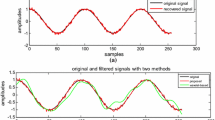Abstract
In oil seismic exploration, automatic picking of first arrivals is very important but difficult for seismic data with low signal-to-noise ratios. In the paper, we proposed a new method based on mutual information in information theory. Mutual information between signals and noises is zero theoretically; thus, random noises have fewer effects on first arrivals pickup with the criterion of mutual information. The paper presents a detailed description of the method based on mutual information. Tests and verification with simulation data and field measurements are carried out. When compared with other well-known methods, the first break picking accuracy and efficiency of the proposed algorithm are verified.








Similar content being viewed by others
Explore related subjects
Discover the latest articles, news and stories from top researchers in related subjects.References
Jiang W, Zhang J (2017) First-arrival traveltime tomography with modified total-variation regularization. Geophys Prospect 65(5):1138–1154
Li Y-D, Dong L-G, Liu Y-Z (2017) First-arrival traveltime tomography based on a new preconditioned adjoint-state method. Chin J Geophys-Chin Ed 60(10):3934–3941
Sun M, Zhang J, Zhang W (2017) Alternating first-arrival travel time tomography and waveform inversion for near-surface imaging. Geophysics 82(4):R245–R257
Zou D, Luo W, Zheng H (2017) First arrival cycle-based calculation methods of in situ sound speed and attenuation in sediments. Mar Georesour Geotechnol 35(1):98–103
Zou M, Zhou Q, Li L, Zhu R, Luo K (2017) Fast residual static correction method using first arrivals in the 3d shot-receiver united domain. Explor Geophys 48(3):246–254
Li Y-D, Dong L-G, Liu Y-Z (2016) First arrival traveltime tomography based on an improved scatteringintegral algorithm. Chin J Geophys-Chin Ed 59(10):3820–3828
Coppens F (1985) First arrivals picking on common-offset trace collections for automatic estimation of static corrections. Geophys Prospect 33:1212–1231
Place J, Malehmir A (2016) Using supervirtual first arrivals in controlled-source hardrock seismic imaging-well worth the effort. Geophys J Int 206(1):716–730
Waheed UB, Yarman CE, Flagg G (2015) An iterative, fast-sweeping-based eikonal solver for 3d tilted anisotropic media. Geophysics 80(3):C49–C58
Hatherly PJ (1982) A computer method for determining seismic first arrival times. Geophysics 47(10):1431–1436
Luo S, Qian J, Zhao H (2012) Higher-order schemes for 3d first-arrival traveltimes and amplitudes. Geophysics 77(2):T47–T56
Lu W, Li Y, Zhang S, Xiao H, Li Y (2005) Higher order-statistics and supertrace-based coherence-estimation algorithm. Geophysics 70(3):P13–P18
Boschetti F, Dentith MD, List RD (1996) A fractal dimension based algorithm for detecting first arrivals on seismic traces. Geophysics 61(4):1095–1102
Jiao L, Moon WM (2000) Detection of seismic refraction signals using a variance fractal dimension technique. Geophysics 65(1):286–292
Sabbione JI, Velis D (2010) Automatic first-breaks picking: new strategies and algorithms. Geophysics 75(4):V67–V76
Cui Y, Wang Y-F (2015) Tikhonov regularization and gradient descent algorithms for tomography using first-arrival seismic traveltimes. Chin J Geophys-Chin Ed 58(4):1367–1377
Stammeijer J, Hatchell P (2014) Standards in 4d feasibility and interpretation. Lead Edge 33(2):134–140
Basler-Reeder K, Louie J, Pullammanappallil S, Kent G (2016) Joint optimization of vertical component gravity and pwave first arrivals by simulated annealing. Geophysics 81(4):ID59–ID71
Author information
Authors and Affiliations
Contributions
Q-JZ and M-YZ were involved in conceptualization. Q-JZ involved in methodology, software and resource selection, writing and preparing original draft, and supervision. M-YZ involved in formal analysis, investigation, data curation and supervision, and in writing, reviewing and editing original draft.
Corresponding author
Ethics declarations
Conflict of interest
The authors declare no conflict of interest.
Additional information
Publisher's Note
Springer Nature remains neutral with regard to jurisdictional claims in published maps and institutional affiliations.
Rights and permissions
About this article
Cite this article
Zhang, QJ., Zhai, MY. First break of the seismic signals in oil exploration based on information theory. Neural Comput & Applic 31, 8229–8237 (2019). https://doi.org/10.1007/s00521-018-3955-6
Received:
Accepted:
Published:
Issue Date:
DOI: https://doi.org/10.1007/s00521-018-3955-6




